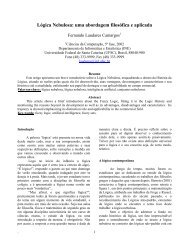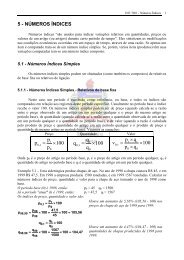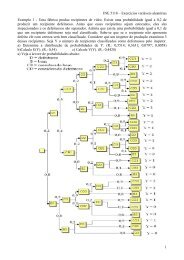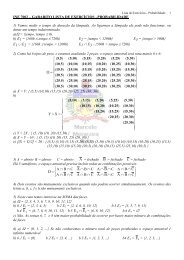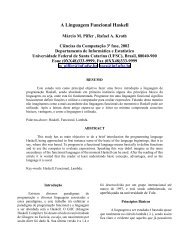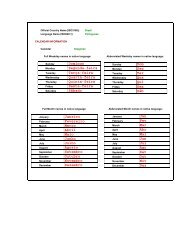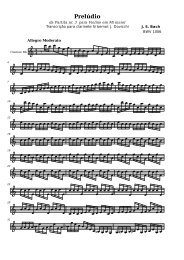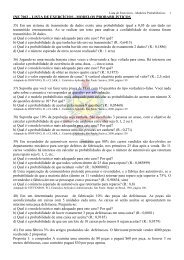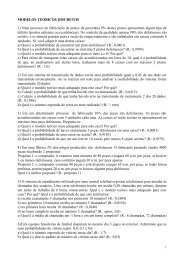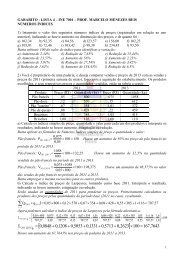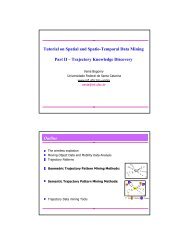Anais do IHC'2001 - Departamento de Informática e Estatística - UFSC
Anais do IHC'2001 - Departamento de Informática e Estatística - UFSC
Anais do IHC'2001 - Departamento de Informática e Estatística - UFSC
Create successful ePaper yourself
Turn your PDF publications into a flip-book with our unique Google optimized e-Paper software.
<strong>Anais</strong> <strong>do</strong> IHC’2001 - IV Workshop sobre Fatores Humanos em Sistemas Computacionais 65<br />
source enco<strong>de</strong>r channel<br />
<strong>de</strong>co<strong>de</strong>r receiver<br />
Figure 1. Shannon and Weaver’s communication mo<strong>de</strong>l<br />
To un<strong>de</strong>rstand the linguistic processes of verbal communication, Jakobson [12] proposed a<br />
mo<strong>de</strong>l in which he i<strong>de</strong>ntifies 6 factors that constitute every verbal communication act. The<br />
addresser sends a message to the addressee. To be effective, the message requires a<br />
context to which it refers, apprehensible by the addressee, a co<strong>de</strong> total or partially common<br />
to both (addresser and addressee), and a contact, a physical channel between the addresser<br />
and the addressee. As in Jakobson’s proposal, the semiotically improved mo<strong>de</strong>l adds the<br />
role of the repertory of signs of both the sen<strong>de</strong>r and the receiver and requires the<br />
overlapping of the two repertories as a necessary condition for communication [5].<br />
Westley and MacLehan [26] proposed a mo<strong>de</strong>l <strong>de</strong>rived from mass communication that<br />
reflects the various interactions among the entities (sen<strong>de</strong>r, receiver and channel), involved<br />
in the communication, including the receiver-sen<strong>de</strong>r, receiver-channel and channel-sen<strong>de</strong>r<br />
directions. In this mo<strong>de</strong>l, the receiver plays an active role. He or she asks for information<br />
and it is this question that <strong>de</strong>termines the content and form of the message created by the<br />
sen<strong>de</strong>r. There are feedback points that seem to better represent the conversational process;<br />
through them, the sen<strong>de</strong>rs can add content to a message or change its form to facilitate the<br />
receiver’s comprehension.<br />
The direct transposition of the mo<strong>de</strong>ls <strong>de</strong>rived from the Information Theory to un<strong>de</strong>rstand<br />
human communication has many drawbacks, however. Parameters such as entropy or<br />
redundancy, while pertinent to “messages” are not the most important and <strong>do</strong> not reflect the<br />
specific nature of human communication. Another difficulty pointed out in the literature<br />
[5] is the unidirectional movement associated to the communication act, from a source (or<br />
addresser) to a receiver (or addressee). Receivers and sen<strong>de</strong>rs actually engage in dialogues<br />
involving a process of meaning negotiation towards a common un<strong>de</strong>rstanding. What<br />
receivers have un<strong>de</strong>rstood from what a sen<strong>de</strong>r has “said” is frequently revealed in what<br />
receivers say themselves when they next take a turn at the communication act [4].<br />
Moreover, these mo<strong>de</strong>ls <strong>do</strong> not explore alternative channels through which the<br />
communication between sen<strong>de</strong>rs and receivers also take place. In our view the diversity of<br />
channels used for communication is what makes it inherently complex and powerful. On<br />
the other hand, mo<strong>de</strong>ls <strong>de</strong>rived from verbal communication <strong>do</strong> not bring into focus the<br />
channel particularities and the ways they can shape the message being conveyed.<br />
In <strong>de</strong>signing the interface (i.e., the message), <strong>de</strong>signers need that users express their needs<br />
and expectations, <strong>de</strong>scribe their tasks, work process, and so on. They exchange i<strong>de</strong>as with<br />
<strong>de</strong>signers, present <strong>do</strong>cuments <strong>de</strong>scribing internal process to <strong>de</strong>signers, show the <strong>de</strong>signers<br />
the co<strong>de</strong>s they use to represent their data, and so on. In <strong>do</strong>ing so, users are communicating<br />
with <strong>de</strong>signers using channels other than the computer artifact alone, so the <strong>de</strong>signers can<br />
un<strong>de</strong>rstand what needs to be <strong>de</strong>signed. On the other hand, <strong>de</strong>signers must check what they<br />
un<strong>de</strong>rstood against what users have “said”; they must represent it in a meaningful way so<br />
they can “talk back” to users about it. They are also using channels to exchange these other<br />
messages; frequently, they are even creating new co<strong>de</strong>s to carry out these communication<br />
acts.



